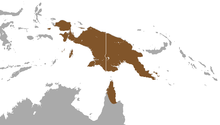Red spiked nose bag
| Red spiked nose bag | ||||||||||||
|---|---|---|---|---|---|---|---|---|---|---|---|---|

Skull and lower jaw of Echymipera rufescens from the collection of the Genoa Museum of Natural History |
||||||||||||
| Systematics | ||||||||||||
|
||||||||||||
| Scientific name | ||||||||||||
| Echymipera rufescens | ||||||||||||
| ( Peters & Doria , 1875) |
The red sting -nosed bucket ( Echymipera rufescens ) is a species of marsupial and lives in New Guinea and northeastern Australia , making it the only representative of the New Guinea-nose bucket in Australia.
Subspecies and distribution
There are two subspecies.
- Echymipera rufescens rufescens , the nominate form of the species, occurs in New Guinea, as well as on Yapen , Misool , the Kei Islands , the Aru Islands and the D'Entrecasteaux Islands .
- Echymipera rufescens australis lives on the Australian Cape York Peninsula in northern Queensland .
features
The red spiked nose bucket reaches a head body length of 21.5 to 54.5 cm, has a 7.5 to 11.5 cm long tail and weighs 0.3 to 3 kg. The Australian subspecies remains smaller with a maximum body length of 48 cm and a maximum weight of 2.2 kg. The largest specimens of the nominate form live in the Gulf Province , the smallest in the region around the Sepik . In both subspecies, the males are usually up to 70% heavier than the females. In exceptional cases, however, females can also reach the maximum weight. The back fur of the animals is yellow-brown, reddish or dark brown. The stiff, spiky hair gives the back fur a brindle look. The belly is light. The top of the head is darkly colored, often completely black. The hair turns gray towards the face. The muzzle is long, the ears are short and rounded. The short, dark tail is hairless. Because of the variability of the species in terms of coat color, the red sting-nosed pouch can be confused with the Clara sting-nosed pouch ( Echymipera clara ) or flat -nosed pouch ( Echymipera kalubu ). In most cases, however, it has a more red-tinted fur and the soles of the hind feet are dark in the red sting-nosed pouch, but not in the flat-sting nosed pouch.
Habitat and way of life
Red spiked-nosed bucks live in all habitats from sea level to heights of around 1200 meters, in exceptional cases even 2000 meters. They occur in lowland rainforests, in the forests of the foothills of the New Guinea Central Mountains, in gallery forests, in heaths, in bush and grasslands. They also live in drier habitats where other spiked-nosed fish are absent. Red spiked noses are strictly nocturnal and spend the day sleeping in hidden nests on the ground or in self-dug burrows. The latter have two or more entrances and exits and are 50 to 80 cm below the ground. Observations on captured specimens show that the animals, and here especially the males, are quarrelsome with one another. In areas that appeal to the animals, up to 20 individuals can live on one hectare.
Like other nasal aspirators, red spiked noseppers are omnivores. A study in the Iron Range on the Cape York Peninsula found that fruits make up around 27% of the population there. Invertebrates made up 26%, mushrooms made up 19% of the diet and leaves made up 18%. The rest of the diet consisted of roots, grass and small vertebrates. In New Guinea, the composition of the food is said to be similar. It is likely that the composition of the food will change with the change of the seasons. The food is found or dug up on the ground. As in the distribution areas of other nasal cones, in regions where the red spiked nasal cone occurs, as a result of the digging activity of the animals, conical, 20 to 30 cm deep holes in the ground are repeatedly found. When searching for food at night, about 1 to 2 hectares are searched and the animals keep using the same trails through the vegetation.
Reproduction
Red spiked-nosed beetles breed in northeast Australia in the rainy season from November to May. During the peak of the rainy season from January to March, 80 to 100% of the females carry young animals in the pouch. In New Guinea, the breeding season may be longer. Females with pups in their pouches were found in March, May, August and October. The number of pups ranged from one to four with a mean of 2.8. There are eight teats in the bag. The pups leave the pouch around 65 days after they are born and are weaned another 70 days later. The animals usually give birth a second time a year, so that each female has an average of 4.9 young a year. These become sexually mature at the age of four to five months.
Danger
The IUCN lists the red spiked nosebug as Least Concern. The range is large, but the subspecies in New Guinea is now rare in large parts of its range and still common in others. The subspecies is heavily hunted for obtaining bushmeat . In addition, large areas of their habitat are being destroyed by bushfires and deforestation for areas for oil palm plantations and other agricultural products. The Australian subspecies is considered harmless. Both are also found in several protected areas.
Individual evidence
- ↑ a b c d e f Christopher Dickman: Family Peramelidae (Bandicoots and Echymiperas). in Don E. Wilson , Russell A. Mittermeier : Handbook of the Mammals of the World - Volume 5. Monotremes and Marsupials. Lynx Editions, 2015, ISBN 978-84-96553-99-6 , page 396.
- ↑ Echymipera kalubu in the Red List of Threatened Species of the IUCN 2016. Posted by: Leary, T., Wright, D., Hamilton, S., Singadan, R., Menzies, J., Bonaccorso, F., Helgen, K. , Seri, L., Aplin, K., Dickman, C. & Salas, L., 2016. Retrieved August 27, 2018.
